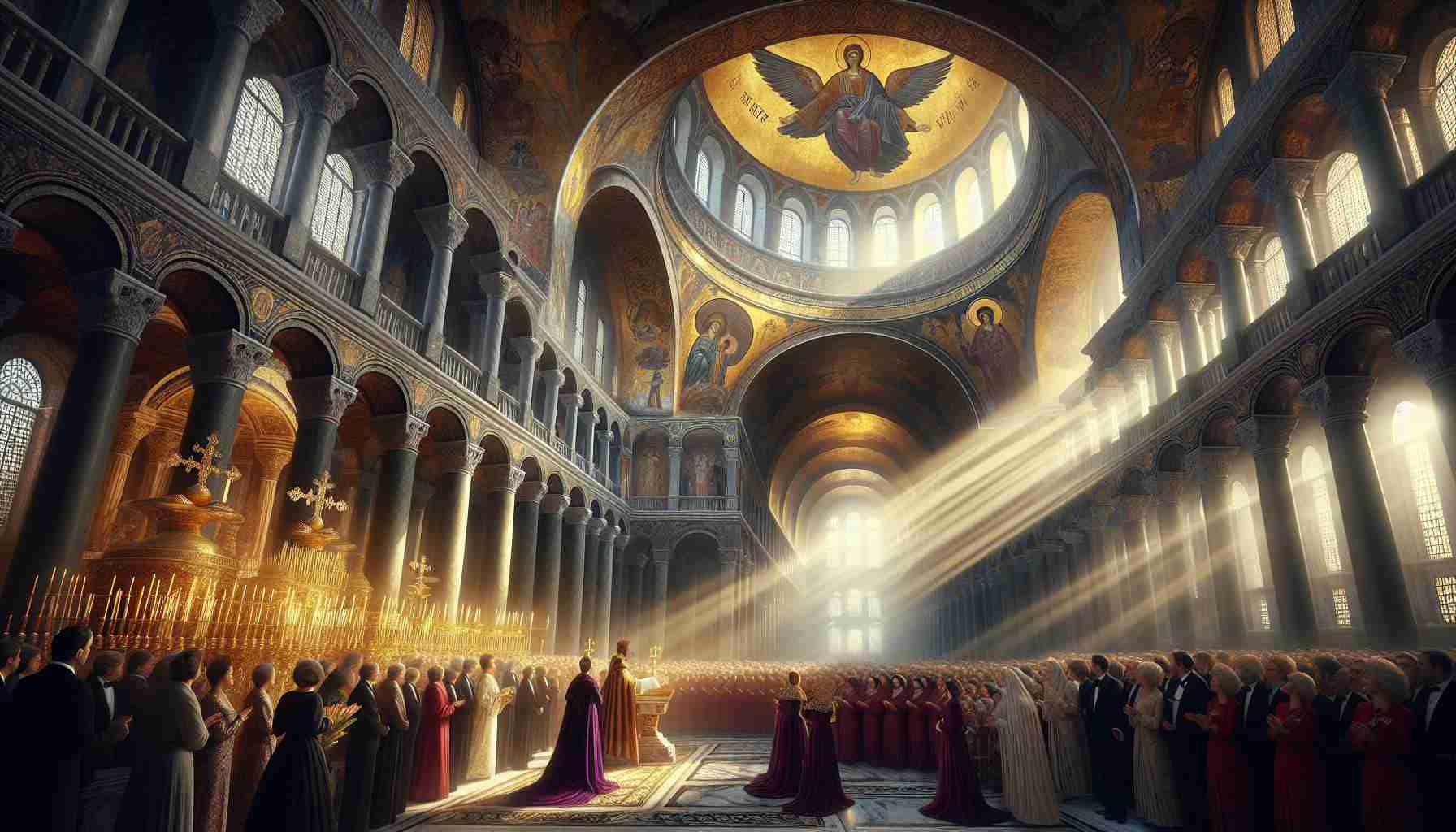

The scent of frankincense curled through the vaulted nave like a prayer offered upward. Sunlight poured through arched windows pierced high in the apse, catching gold mosaic—Christ Pantocrator gazing down with judgment and blessing. The crowd filling the massive dome of the Hagia Sophia stood mute with wonder, the hush broken only by the solemn steps of crimson-robed deacons and the echo of chanting spiraling into stone.
It was the twenty-seventh day of December, in the five hundred and thirty-seventh year since the Incarnation of the Logos.
Emperor Justinian stood beneath the central dome, clad in imperial purple clasped at the throat with a brooch of onyx and pearl. He did not smile. His eyes lifted—not to the patriarch, nor to the crowded nobility—but to the seeming-flame of heaven above his head. A dome vast enough to rival the sky, rising thirty stories without visible support. Hanging, it seemed, from a golden chain suspended from the heavens.
“Glory and beauty are before Him; strength and honor are in His sanctuary,” the patriarch intoned in Greek, his aging voice lined with tears. Psalm ninety-six, verse six. The anthem rolled over the gathered faithful, some of them still bearing bruises and burn scars from only five years before, when fire and fury nearly consumed Constantinople with the Nika Riots. In that violence, the city’s churches had fallen, including the second Hagia Sophia.
Now it had risen again—not in kind, but in triumph.
Anthemius of Tralles and Isidore of Miletus, mathematicians as much as architects, had defied reason and precedent. Their engineers—some whispering in awe, others stumbling off scaffolds with spines cracked—had erected the dome not once but twice. The first collapsed in an earthquake. The second, risen higher still, soared above a forest of forty marble ribs—a feat rumored to draw envy even from the angels.
Procopius—the great chronicler and silent voice of scandal—later claimed that when Justinian first crossed the threshold of the completed church, he cried aloud, “Solomon, I have surpassed thee!”
Some whispered it was blasphemy. Others believed it prophecy.
Along the nave, veiled women wept openly. Greek, Latin, Armenian, Syriac—tongues murmured prayers in a cacophony of Christian dialects, gathered into one echo beneath the dome. The mosaics of saints blinked in the candlelight: the Virgin enthroned, saints in procession, the Cross and Throne framed by vines of gold on fiery crimson.
Like the city itself, the Hagia Sophia was a crucible of East and West.
But even in its consecration, shadows moved. Rumors swirled through the halls that coins bearing old pagan symbols had been mixed in with the cement. A tribute to the emperor’s ancestors, or the stonemasons’ defiance? No one dared ask aloud. One of the artisans—a Syriac Christian—claimed that an angel had appeared atop the scaffolding during construction, hands raised in warning. Another swore he had seen a star fall through the oculus and disappear into the altar stone.
Mystery clung to the place. As layered as gold leaf on its shimmering icons.
Still, the people came—thousands the first day, swelling by tens of thousands in the months to follow. They came to stand on porphyry floors dragged from distant Egypt, to see pillars lifted from Artemis’ temple in Ephesus, now carved with crosses. To hear the liturgy echo like thunder through vaults as massive as Roman bathhouses. Bells rang, censers smoked, priests processed. Voices rose.
And the dome—always the dome—shimmered with otherworldly glow, light pouring in through its ring of windows like a crown of fire.
It was said by those present that one soldier dropped his sword upon crossing the threshold, too overcome to take another step into such holiness. Another, a Goth from the northern frontier, fell to his knees and repented his campaigns. He left the city as a novice, walking barefoot toward Mount Athos.
Within the sanctuary, the Eucharist was lifted. The Body of Christ raised high under the mosaic Christ enthroned. One mirrored the other, heaven and earth touching.
A boy of ten, missing two toes and left by his mother near the ambo to seek healing, watched in awe. He would later become a priest. Centuries later, his name would be lost, but the marble his small hand had grazed would still bear an oily sheen from the touch of pilgrims, kissed smooth through time.
Beyond the empire’s edges, ambassadors carried word back: the Christian East had built a temple not only to house men, but to humble them.
Hagia Sophia—Holy Wisdom—was no mere church. It was a theological declaration in stone and glass. In a city that straddled Europe and Asia, the East and the West, the visible and the invisible, it stood as a bridge across every divide.
It would be conquered. Redeemed. Converted and reconverted. Its mosaics hidden, uncovered, forgotten, restored.
But on that winter day in 537, its dedication rang like a thunderclap through the ages. Not only one man’s glory nor one empire’s boast—but faith made visible in gold and sky.
And somewhere high above, light filtered through the windows of the dome, stirring the dust like angels dancing.